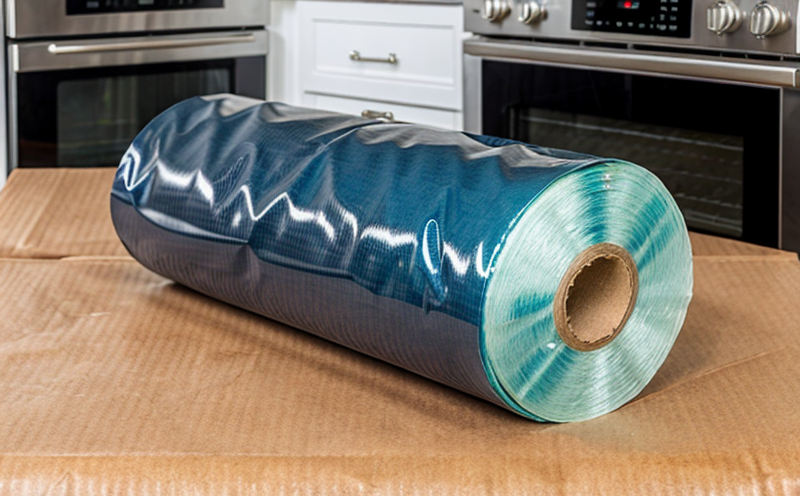ISO 175 Chemical Resistance Testing of Plastic Wraps
The ISO 175 chemical resistance testing method is a critical procedure used to evaluate the durability and integrity of plastic wraps, particularly those used in household applications. This test assesses how well these materials withstand exposure to various chemicals without undergoing significant degradation or loss of properties.
Chemical resistance testing is essential for ensuring that packaging meets regulatory standards and performs optimally under real-world conditions. For instance, many household wraps are exposed to common cleaning agents like detergents, bleach, and water during their lifecycle. These exposures can alter the physical properties of the plastic, leading to potential performance issues such as reduced tensile strength or increased permeability.
The ISO 175 test follows a standardized procedure that involves placing specimens of the plastic wrap in contact with specified chemical solutions for defined periods. The test aims to determine whether there are any observable changes in the physical properties, appearance, or functionality of the material after exposure. Specimens may be examined visually and mechanically before and after testing.
Understanding the chemical resistance of a plastic wrap is vital for several reasons. For quality managers, it ensures that products meet specifications and standards set by international bodies like ISO. Compliance officers rely on such tests to confirm that their materials comply with relevant regulations. R&D engineers use this information to develop new formulations or improve existing ones. Procurement teams benefit from knowing which suppliers offer products that maintain performance under expected chemical exposures.
The test parameters for ISO 175 are strictly defined in the international standard, ensuring consistency across different laboratories and regions. Specimens must be prepared according to specific dimensions and tolerances before being immersed in the chosen chemicals. The duration of immersion varies depending on the type of chemical but is typically between one hour and seven days.
After removal from the test solution, specimens are visually inspected for any changes in color, texture, or appearance. Mechanical tests such as tensile strength measurement might also be conducted to assess whether there has been a significant change in the material’s physical properties. Acceptance criteria specify what constitutes acceptable limits of change; deviations beyond these thresholds would indicate insufficient chemical resistance.
- Visual inspection: Checking for color changes, texture alterations, or visible damage.
- Tensile strength testing: Measuring the force required to break a sample of the plastic wrap after exposure.
- Bubble point test: Evaluating permeability by assessing how quickly air bubbles form through the material when exposed to pressure.
Scope and Methodology
The ISO 175 chemical resistance testing method covers a wide range of plastic wraps used in household applications. This includes films, sheets, and other thin materials designed to protect food items or provide structural support during transportation.
The scope encompasses both thermoplastics and thermosetting plastics commonly found in these types of packaging. Thermoplastics are particularly suitable for this type of testing due to their ability to soften and regain shape upon reheating, allowing them to undergo repeated cycles of chemical exposure without permanent deformation.
Thermoplastic examples include polyethylene (PE), polypropylene (PP), polystyrene (PS), and polyvinyl chloride (PVC). Thermosetting plastics like phenolic resins or urethanes, while less common in household wraps, are also within the scope of ISO 175. However, their testing might require additional considerations due to their non-reversibility once cured.
The methodology for performing this test involves several steps:
- Preparation: Cutting specimens from the plastic wrap according to specified dimensions and tolerances.
- Immersion: Placing the prepared specimens in a container filled with the chosen chemical solution at room temperature or under controlled conditions if required by the specific test scenario.
- Duration: Allowing the specimens to remain immersed for the prescribed duration, which can vary from one hour up to seven days based on the chemical used and desired outcome of the test.
- Post-test evaluation: Removing the specimens from the solution and conducting visual inspections followed by mechanical tests if necessary. Comparing these results with baseline data collected prior to immersion helps determine any adverse effects caused by the chemical exposure.
Eurolab Advantages
Eurolab prides itself on offering comprehensive and accurate ISO 175 chemical resistance testing services tailored to meet the specific needs of our clients across various industries. Our team of highly skilled technicians ensures that each sample is handled with precision, following stringent quality control protocols throughout every stage of the process.
We utilize state-of-the-art equipment calibrated according to international standards to ensure reliable and repeatable results. This allows us to provide consistent data that can be trusted by our customers when making decisions about their packaging materials.
Our experienced engineers work closely with clients during all phases of the project, from initial consultation through final report delivery. They offer valuable insights into potential areas for improvement or optimization based on test results. Additionally, our laboratories follow strict environmental and safety practices to ensure that all tests are conducted responsibly and sustainably.
With Eurolab’s advanced facilities and expertise, we can support clients in meeting rigorous regulatory requirements while enhancing product performance and extending shelf life. Whether you need assistance with new product development or ongoing quality assurance efforts, our ISO 175 chemical resistance testing service offers unparalleled value and reliability.





